Heavy wheeled loaders: The workhorse of the construction site
06 June 2023
From construction and mining to earthmoving and material handling, Catrin Jones looks at how heavy wheeled loaders bring efficiency, productivity and safety to major projects.
Heavy wheeled loaders have a home in almost every construction site and operators are spoilt for choice with the innovative machines manufacturers are releasing.
Komatsu Europe displayed the new WA800-8 wheeled loader at the demo ground at Bauma Munich in October 2022. The loader is said to have been designed for maximum operating comfort in addition to featuring a modulation clutch, variable traction control, an auto kick down and an RPM set.
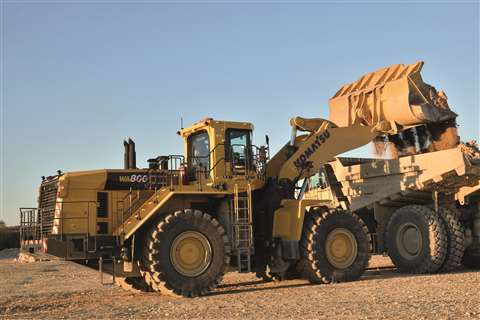 Komatsu’s WA900-8 in action (Photo: Komatsu)
Komatsu’s WA900-8 in action (Photo: Komatsu)
The Japan-based company has also redesigned the machine’s extra-large 11.5m³ bucket, complete with its optimised maximum fill feature.
With a total operating weight of 115 tonnes, the WA800-8 meets the latest EU stage V emission regulations with a Komatsu-designed, developed and manufactured engine and after-treatment system.
“Our WA800 has always been well-appreciated for its reliability and productivity”, says Jo Monsieur, group manager for large machines at Komatsu Europe.
“And this latest generation surely continues this legacy. Furthermore, Komatsu has really set new standards for stability, comfort and safety and we are very proud to be able to offer this to our customers.”
Performance enhancements on heavy wheeled loaders
Liebherr’s XPower wheeled loaders have established themselves at the forefront of fuel efficiency and robustness.
Liebherr says one reason is their power-split travel drive, installed as standard in all Liebherr XPower wheeled loaders. The combination of hydrostatic drive – advantageous for material uptake and travelling over short distances – and mechanical drive ensure that the machine works at maximum efficiency.
In addition to the two drive types, Liebherr offers a range of intelligent assistance systems for its mid-size and XPower wheeled loaders, including active personnel detection with brake assistance. The optional assistance system warns the machine operator of hazards in the rear area of the machine. Sensors and artificial intelligence combine to distinguish between people and objects for additional safety. As soon as the sensors detect a source of danger, the brake assistant automatically decelerates the wheel loader‘s speed. This shortens the stopping distance by multiple feet, reducing the frequency and intensity of potential accidents.
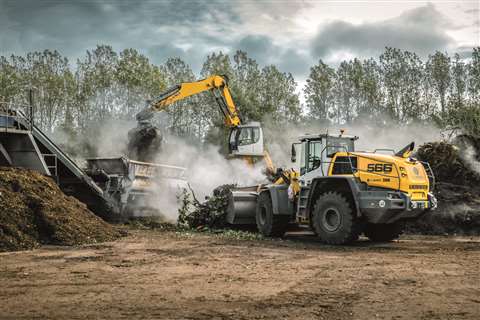 Liebherr machines hard at work in Denmark (Photo: Liebherr)
Liebherr machines hard at work in Denmark (Photo: Liebherr)
In Denmark, 40 Liebherr XPower wheel loaders are being used for material handling at RGS Nordic – which specialises in recycling construction and demolition waste materials.
Michael Jørgensen, strategic purchasing manager, commented, “The Liebherr wheel loaders need less fuel, are powerful and have hardly any downtime. We are particularly impressed that we achieve 30% more productivity with the same fuel consumption than with comparable wheel loaders in this size class.”
RGS Nordic was in the market for efficient wheel loaders with power-split drive to reduce CO2 emissions. With the company’s main focus on converting construction waste into reusable and circular products that can be integrated into the product cycle, it was important for the machinery used to reflect the same values.
Maximising capacity
Develon, formerly known as Doosan Construction Equipment, now offers the company’s latest generation ‘DL-7’ wheel loader range driven by new Stage V compliant engines and providing higher productivity, increased fuel efficiency and a low cost of ownership, coupled with a new cab offering an enhanced experience for the operator.
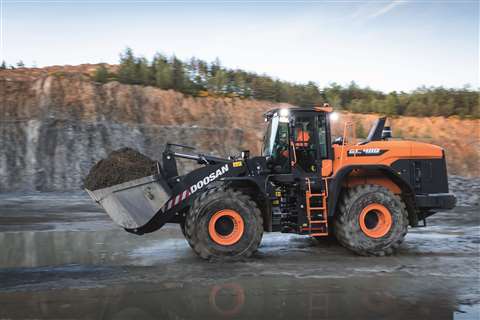 Formerly Doosan, Develon now offers the latest generation of wheeled loaders (Photo: Develon)
Formerly Doosan, Develon now offers the latest generation of wheeled loaders (Photo: Develon)
The four biggest standard models in the DL-7 range are the DL420-7, DL480-7, DL550-7 and DL580-7. The machines feature redesigned buckets offering up to 7% more capacity with maximum bucket capacities from 4.5 to 6.4 m3. Develon says that this provides increased productivity for a wide range of material-handling applications.
In addition to the company’s wheel loader range, Develon has introduced the ‘world’s first “transparent bucket” system’ for wheel loaders. The system is said to enable the wheel loader driver to see the blind spots in front of the machine’s bucket, using a monitor installed in the cab. By recording images with top and bottom front-loaded cameras and projecting the combined images in real-time using a curved projection method, the transparent bucket system provides a full view for the driver.
Develon says that the transparent bucket system addresses the issue of safety concerns caused by blind spots in front of wheel loaders due to their buckets. With this new feature, drivers can now easily check blind spots in front of the bucket via the cab monitor, increasing safety and reducing accidents.
Moreover, the transparent bucket system is said to enhance work efficiency by providing a forward view for the driver during loading, unloading, or carrying materials like aggregates, sand, and soil.
The company has applied for patents in Korea, North America, Europe, and China, making it the first company to develop and implement a front projection function with a transparent bucket for construction machinery.
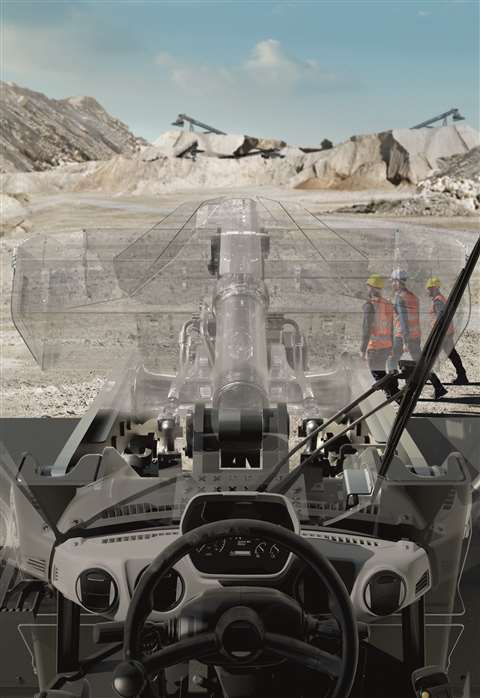 Develon’s transparent bucket is a ‘world first’ (Photo: Develon)
Develon’s transparent bucket is a ‘world first’ (Photo: Develon)
A Develon spokesperson stated that advanced safety systems have become crucial in equipment selection with increasing safety standards. The company plans to continue developing safety features that prioritise driver and worker safety, aiming to lead the industry towards safer and accident-free construction sites.
What are the electromobility solutions for heavy wheeled loaders?
Volvo Construction Equipment (Volvo CE) has taken a major step forward in advancing its electromobility offerings with a new solution.
The company has converted its L120 wheel loader into an electric version, catering to the increasing demand for sustainable solutions in the mid-size range. The conversion was done in collaboration with partners Parker Hannifin and CE Engineering Solutions, a Volvo Group subsidiary.
The L120H Electric Conversion, available to selected customers in Europe from 2023, will provide the same performance as the conventional machine while emitting zero emissions.
Volvo CE says that it is committed to achieving a carbon-neutral construction industry and has partnered with CE Engineering Solutions and other electromobility partners to accelerate the availability of commercialised electric solutions across all segments and applications. This collaboration is part of the company’s efforts to expand its line of electric wheel loaders, following its investment in Dutch manufacturer Limach in June to broaden its electric excavator portfolio.
The L120H Electric Conversion is expected to provide numerous benefits to the construction industry, including reduced noise pollution, lower operating costs, and increased productivity. The machine’s electric powertrain also offers instant torque, making it more responsive and efficient than traditional combustion engines.
In addition, the electric version is designed to require less maintenance than its diesel counterpart, reducing downtime and increasing overall equipment availability.
Powered by 240 kWh batteries, the L120H provides a runtime of approximately five hours in most medium-duty applications. Consistent with Volvo’s existing charging solutions, it is estimated to charge from 0-100% in just 1.5-2 hours.
‘Change starts here’
Carl Slotte, head of sales region Europe at Volvo CE, says, “There is no time to wait – we need to deliver solutions that allow our customers to achieve their decarbonization goals. Change starts here.
“Our commitment to partnership allows us to take a leading position in transforming our industry, with electric solutions that are built to fulfil market demand and tailored to suit the changing needs of our customers. Working together, we are scaling up our portfolio of electric machines, extending the versatility of our range and transforming our industry towards a carbon-neutral future.”
Depending on market demand, Volvo CE says there could be the possibility to convert existing users’ L120H wheel loaders to electric in the future.
Beyond sustainability, Volvo CE is significantly developing the safety systems that are available on their wheeled loaders.
Volvo CE has launched its Collision Mitigation System for Volvo Wheel Loaders, which aims to support operator response and reduce the risk of collision when working in reverse. The feature automatically applies the service brakes when the wheel loader approaches an obstacle, helping to mitigate the consequences of accidents and reduce the risk of unplanned interruptions.
The system is designed to facilitate job site safety and remembers the last slope the machine climbed for seamless stockpiling operations. Volvo CE says that it can be temporarily deactivated for specific site conditions and only functions when the wheel loader is in reverse and driving between 3-15 km/h. The Collision Mitigation System is a factory-fit option for a range of Volvo wheel loaders and is available globally.
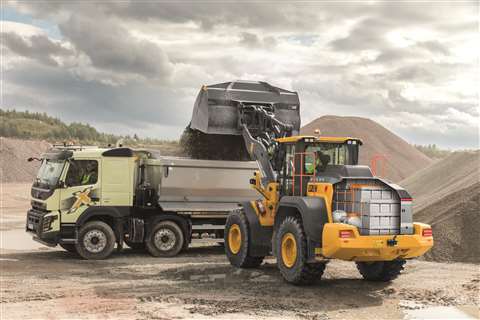 Volvo CE says there could be the possibility to convert existing users’ L120H wheel loaders to electric in the future (Photo: Volvo CE)
Volvo CE says there could be the possibility to convert existing users’ L120H wheel loaders to electric in the future (Photo: Volvo CE)
Lars Eriksson, global product manager for wheel loaders at Volvo CE says, “We at Volvo CE continue to proactively develop intelligent solutions which not only mitigate the consequences of accidents but strive to avoid them altogether.
“This new Collision Mitigation System is one important part of our work to reduce the risk of accidents and help fulfil our commitment towards zero accidents.”
Volvo CE has developed the Collision Mitigation System in-house for its line of wheel loaders. This factory-fit option is currently offered on the L110H/L120H equipped with OptiShift, L150H, L180H, L220H, L260H, and L200H High-Lift wheel loaders.
To function, it requires a Radar Detect System to be installed, adding to the existing range of features, options, and site services designed by Volvo CE to promote job site safety and reduce unforeseen interruptions.
The heavy wheeled loader market is certainly busy. Enhancements are being made left, right and centre with almost a solution for everything. As always, it is an exciting time in equipment development and the year is sure to bring about more innovations.





